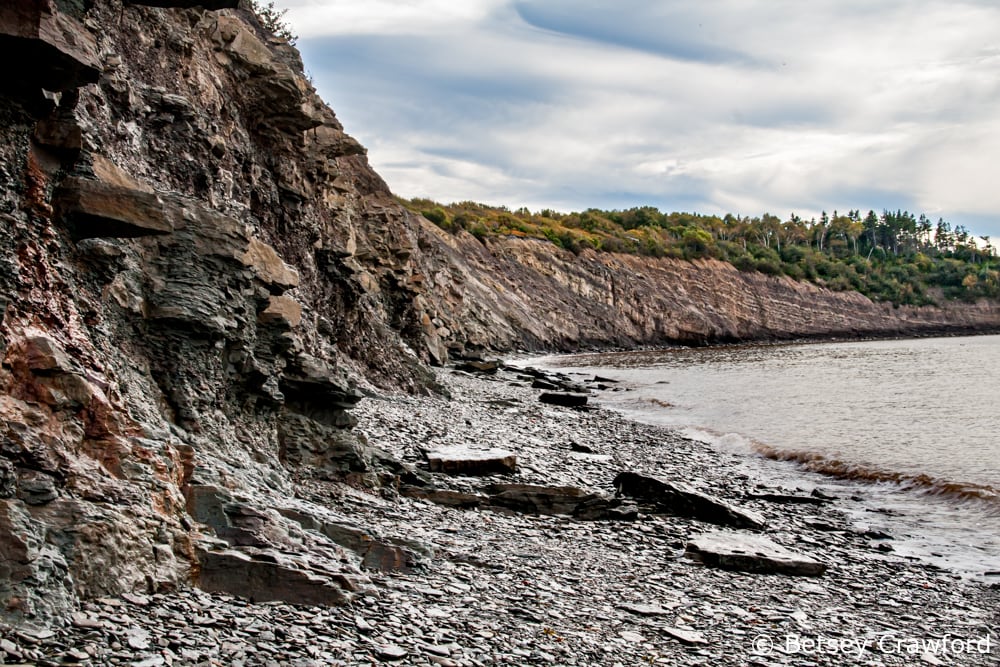 I fell down a 300 million-year-old rabbit hole recently, and had such a good time there I’m now bringing you with me. I was looking for something else and came across my photographs from a visit to Joggins Fossil Cliffs in Nova Scotia. The Canadian Maritime provinces were the first places George and I visited when we headed out on our journey in 2011. We planned to spend three weeks but found it so magical we were there for six, and visited the Bay of Fundy on the way out. This was four years before I started the website, so I’ve never written about the thrill of standing ankle-deep in fossils.
I fell down a 300 million-year-old rabbit hole recently, and had such a good time there I’m now bringing you with me. I was looking for something else and came across my photographs from a visit to Joggins Fossil Cliffs in Nova Scotia. The Canadian Maritime provinces were the first places George and I visited when we headed out on our journey in 2011. We planned to spend three weeks but found it so magical we were there for six, and visited the Bay of Fundy on the way out. This was four years before I started the website, so I’ve never written about the thrill of standing ankle-deep in fossils.

The Bay of Fundy is famous for its extravagant tides. More than 176 billion tons of water flow with the tides into and out of its narrow 270-mile length, more than the water flowing through all the rivers of the world combined. With pressure building up as the water flows northeast into a narrowing, shallower basin, the beaches farthest in can have a 53’ difference — the worldwide average is 3-4’ — between high and low tide. The two photos below were taken as I walked the beach at our RV park. You can see how much higher up the beach I needed to be for the incoming tide picture.
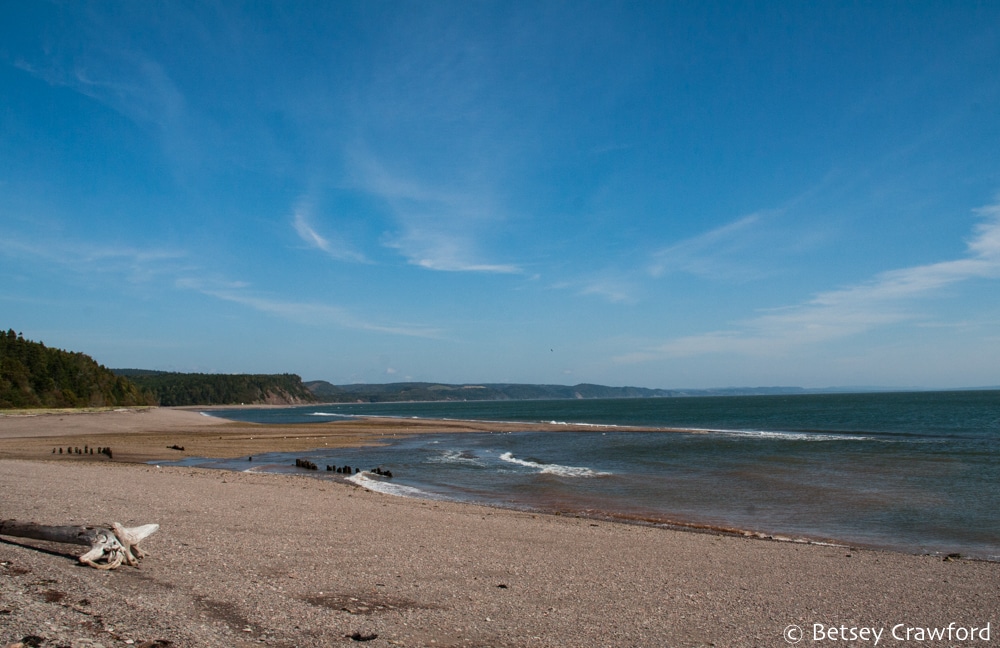 This rush of water constantly erodes the sedimentary sandstone and shale that create the nine miles of cliffs you can see at Joggins in the top photo. Because the sediment layers are thin, the rock breaks off easily and the beach is literally formed by fossil-bearing rocks from the Carboniferous Period, 354 to 290 million years ago. In the walls of the cliffs you can see fossils of tree trunks. And, because of the force of the water, whole new crops of fossils are uncovered every three or four years.
This rush of water constantly erodes the sedimentary sandstone and shale that create the nine miles of cliffs you can see at Joggins in the top photo. Because the sediment layers are thin, the rock breaks off easily and the beach is literally formed by fossil-bearing rocks from the Carboniferous Period, 354 to 290 million years ago. In the walls of the cliffs you can see fossils of tree trunks. And, because of the force of the water, whole new crops of fossils are uncovered every three or four years.
300 million years ago the land we call Nova Scotia, now northeast of Maine, was at the equator. The vast continent of Pangaea hadn’t yet formed, much less split apart into the continents we know today. It was a tropical land of giant ferns and horsetails whose descendants are still with us. There were tree-like plants, sigillaria (above), related to our modern mosses, not to the trees we now know. Their firm trunks were created by closely packed leaf bases as the plant grew to 100’. Grass-like leaves grew in spirals around the trunk, which surrounded soft interior tissue that easily decomposed, allowing the trunks to fill with silt that eventually hardened into rock. Sections of sigillaria roots (below) were easy to find. Rootlets would have grown from the indentations.
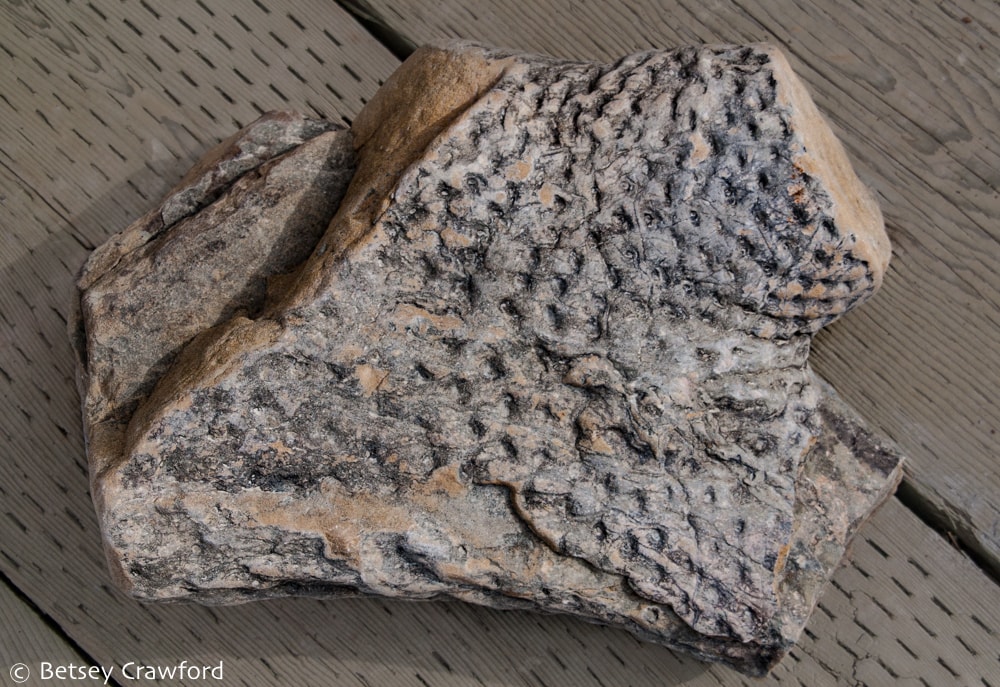 For much of the Carboniferous, the land, with temperatures 40°F warmer than today and a higher percentage of atmospheric oxygen, would have been filled with lush swamps and wet forests. Relatively frequent, light inundations of silt-bearing water left many separate layers of sediment into which were trapped plants and the remains of small amphibians and the earliest reptiles. These remains represent a crucial link to a time when our ancestors were still moving between living on land and in water. As the sediment layers turned to mud and dried, they preserved the prints and skeletons of these tiny animals as well as the gentle wave action of the water.
For much of the Carboniferous, the land, with temperatures 40°F warmer than today and a higher percentage of atmospheric oxygen, would have been filled with lush swamps and wet forests. Relatively frequent, light inundations of silt-bearing water left many separate layers of sediment into which were trapped plants and the remains of small amphibians and the earliest reptiles. These remains represent a crucial link to a time when our ancestors were still moving between living on land and in water. As the sediment layers turned to mud and dried, they preserved the prints and skeletons of these tiny animals as well as the gentle wave action of the water.
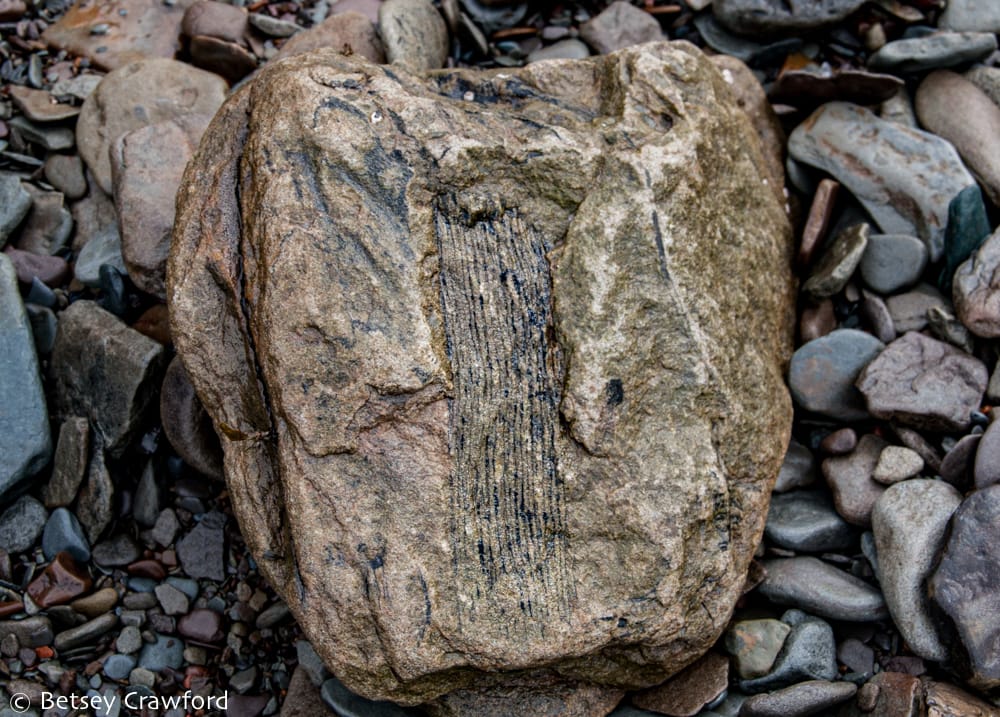
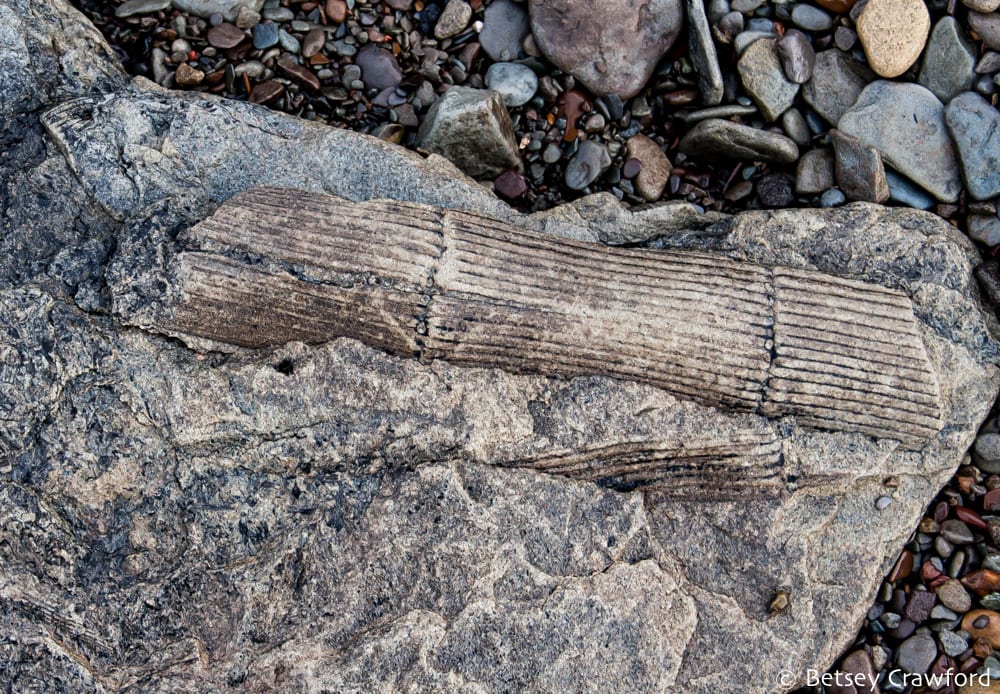 The most common fossils are calamites, above, the ancestor of the horsetail (below) from a local hike last year. They are abundant in the Pacific Northwest, the last remnants of a once much larger genus. These living fossils are tall if they reach my waist. In the Carboniferous they were 30’ high and formed vast stands, like modern-day forests of bamboo.
The most common fossils are calamites, above, the ancestor of the horsetail (below) from a local hike last year. They are abundant in the Pacific Northwest, the last remnants of a once much larger genus. These living fossils are tall if they reach my waist. In the Carboniferous they were 30’ high and formed vast stands, like modern-day forests of bamboo.

They are considered a type of fern, our modern horsetails emerging during the Jurassic period, 200 to 145 million years ago. Modern ferns showed up during the Cretaceous (145 to 66 mya). But, as you can see below, they still look like their 300-million-year old ancestors, a result of reproducing by spores, rather than by sexual reproduction as the much more recent flowering plants do. The latter method, by mixing genes from different parents, creates the possibility of wide variation in color, form, adaptability. That’s why there are 300,000 species of flowering plants and only 12,000 species of ferns and a handful of horsetails.
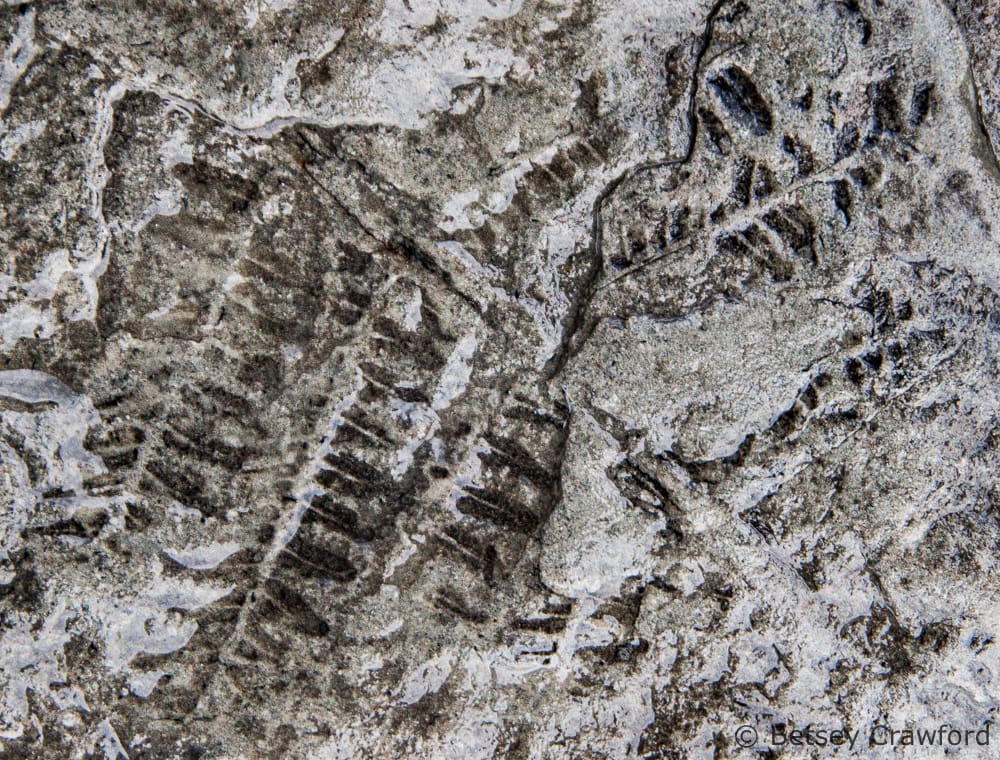
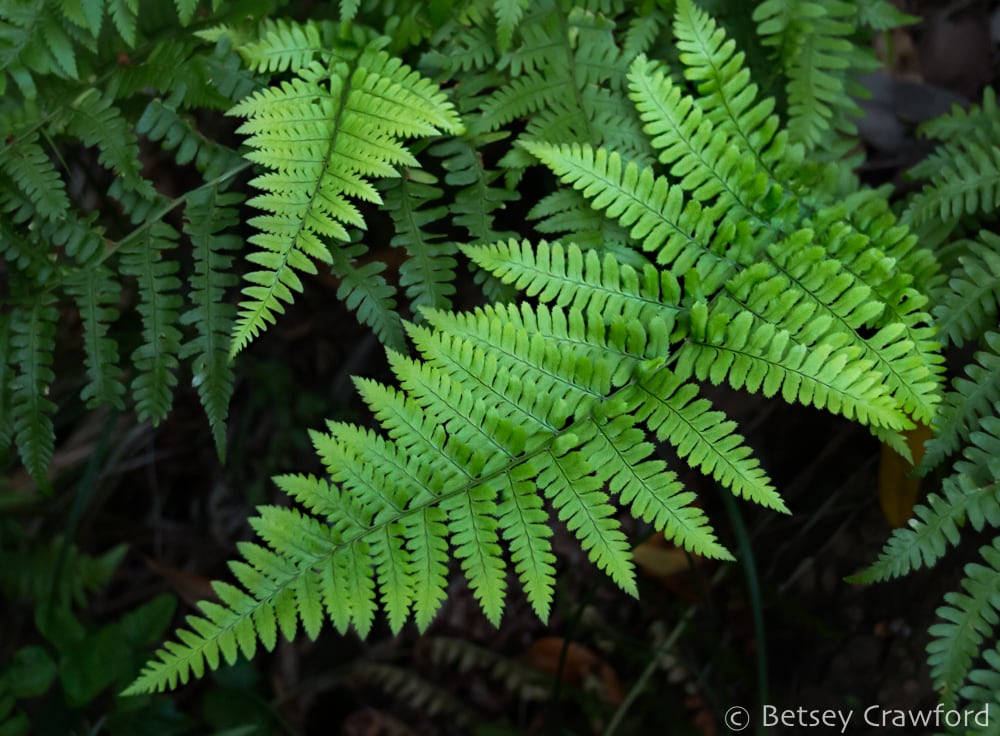 Other existing forms of life, like the seaweed below, also had echoes from the distant past.
Other existing forms of life, like the seaweed below, also had echoes from the distant past.
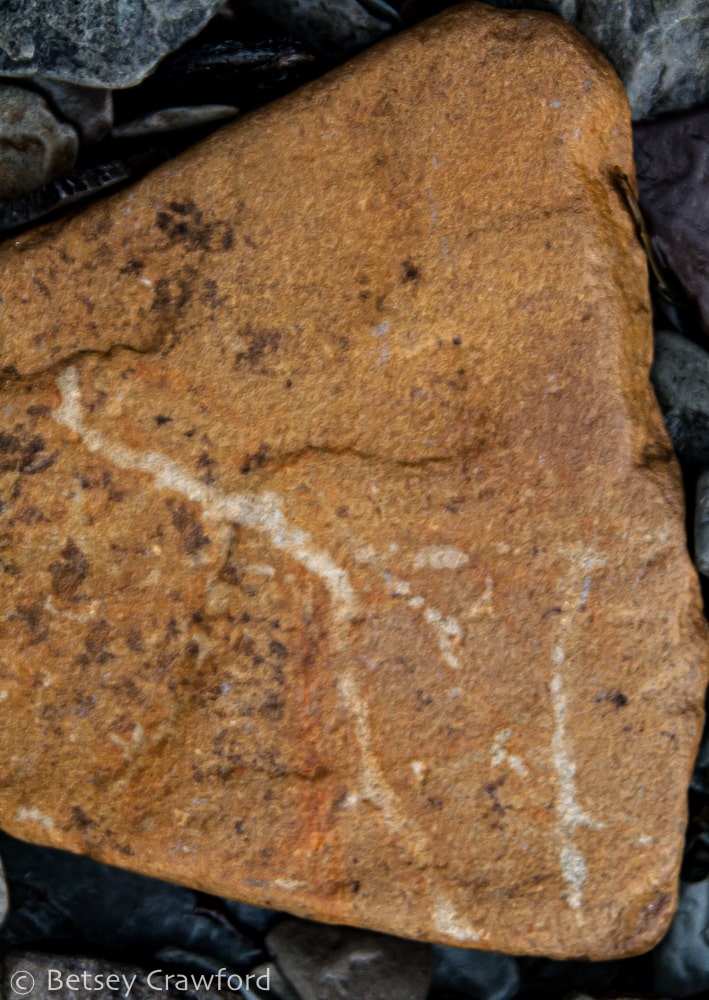 The Carboniferous, as long ago as it was, is with us every minute of our modern life. The term fossil fuels refers to these fossils worldwide. The vast forests of green plants from this warm, damp time didn’t decay as they died into the watery marshes. Instead, their remains accumulated and were eventually pressed first into peat and eventually into coal as sediment layers stacked up. More layers added more weight, creating enough compression to liquify the carbon into oil. Joggins was the first place in North America to be mined for coal, starting in 1680. It is no longer, but the coal is still there. The collapsed mine shaft below rests on an exposed seam of coal.
The Carboniferous, as long ago as it was, is with us every minute of our modern life. The term fossil fuels refers to these fossils worldwide. The vast forests of green plants from this warm, damp time didn’t decay as they died into the watery marshes. Instead, their remains accumulated and were eventually pressed first into peat and eventually into coal as sediment layers stacked up. More layers added more weight, creating enough compression to liquify the carbon into oil. Joggins was the first place in North America to be mined for coal, starting in 1680. It is no longer, but the coal is still there. The collapsed mine shaft below rests on an exposed seam of coal.
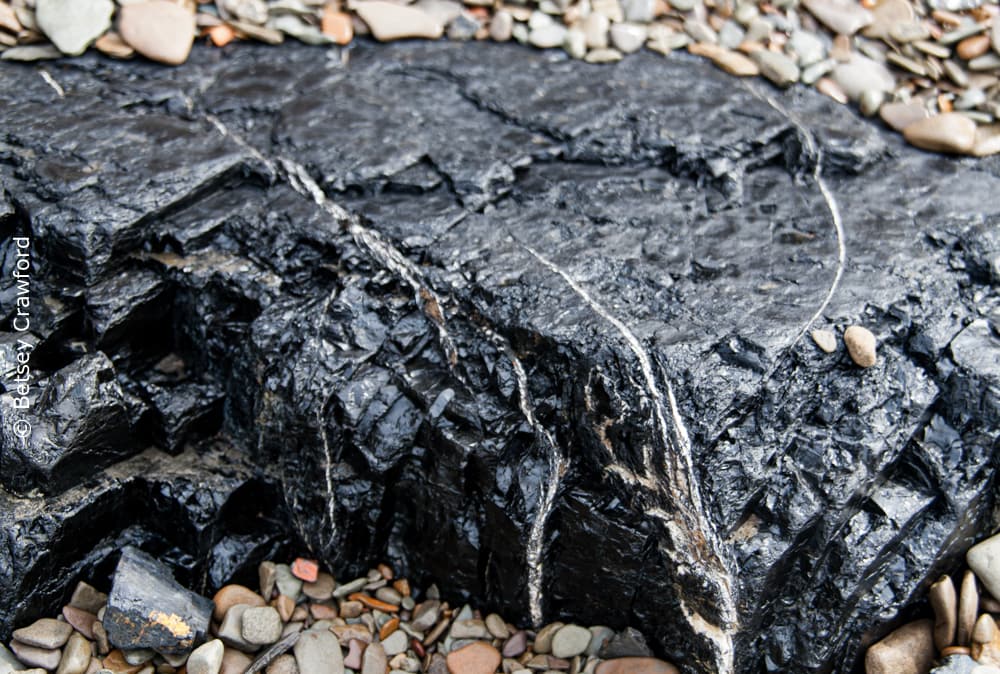 It’s also with us every day because our earliest terrestrial animal ancestors emerged then. Joggins is a UNESCO World Heritage Site and it’s easy to see why. The oldest fossil tetrapods, vertebrate animals with legs instead of fins, are here. Their kin would go on to become amphibians, reptiles, mammals, and birds. The earliest fossils of tetrapods that laid eggs that didn’t need to be in water to survive, called amniotes, are found here. These were the first animals able to leave aquatic life and spread out on land. The earliest known reptile, Hylonomus lyelli, found at Joggins in the mid-nineteenth century, was an amniote. The oldest fossil synapsids, forerunners to our modern mammals as well as all ancestral forms, are here.
It’s also with us every day because our earliest terrestrial animal ancestors emerged then. Joggins is a UNESCO World Heritage Site and it’s easy to see why. The oldest fossil tetrapods, vertebrate animals with legs instead of fins, are here. Their kin would go on to become amphibians, reptiles, mammals, and birds. The earliest fossils of tetrapods that laid eggs that didn’t need to be in water to survive, called amniotes, are found here. These were the first animals able to leave aquatic life and spread out on land. The earliest known reptile, Hylonomus lyelli, found at Joggins in the mid-nineteenth century, was an amniote. The oldest fossil synapsids, forerunners to our modern mammals as well as all ancestral forms, are here.
Indications of evolving animal behavior offer fascinating insights into not just evolution but its speed once animals were free to roam the earth and adapt to suitable habitats. There are fossil combinations that indicate very early tetrapods took care of their young. Fossil jaws show grinding teeth that indicate early herbivores were adapting to a plant-filled terrestrial environment.

For someone who loves plants as much as I do, wandering the Joggins beach and picking up rock after rock bearing the traces and forms of ancient plants was thrilling. I walk among the descendants of these elders every day. Their endurance and adaptability are awe inspiring. I didn’t find any animal fossils on the beach, but did see them in the museum. Contemplating those tiny bones and jaws, whose biting teeth are clearly ancestors of my own, brings me an empowering sense of my own lineage in deep time. I share genes with these beings, plant and animal. Evolution is thrifty. No need to invent genetic information for every different life form or species. We all go back to the earliest bacterial life forms. The life force born in them is born in us anew.
This sense of connection is what I called in another essay the solace of deep time: our embeddedness in the creative force that is the cosmos. I’m also reminded, as we ever face more instances of our limited evolution as a species, that it all takes a very long time. That is not consoling, certainly. But wandering among the ancients tells me that I live on a planet meant for life. That I and all my fellow current beings are manifestations of that vital drive. And, if we are willing, we can enter into that energy and take on its mantle for the good of all.

I’d love to have you join me! If you add your email address, I’ll send you notices of new monthly posts.[madmimi id=178565]/
Related posts:
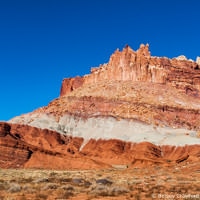
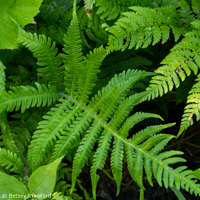
the long consolation of ferns

the power of interrelatedness

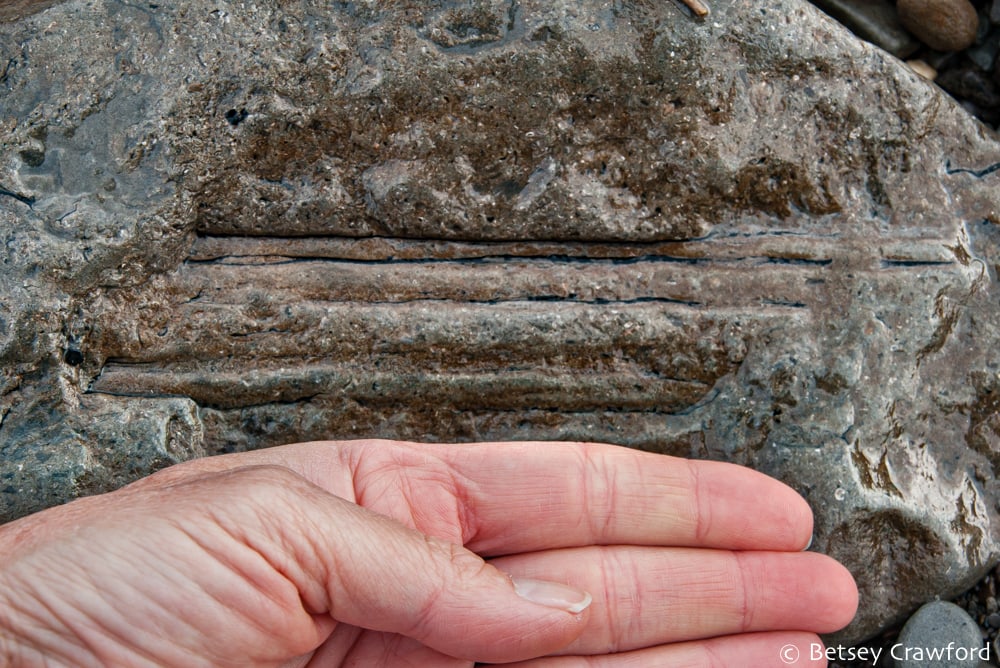

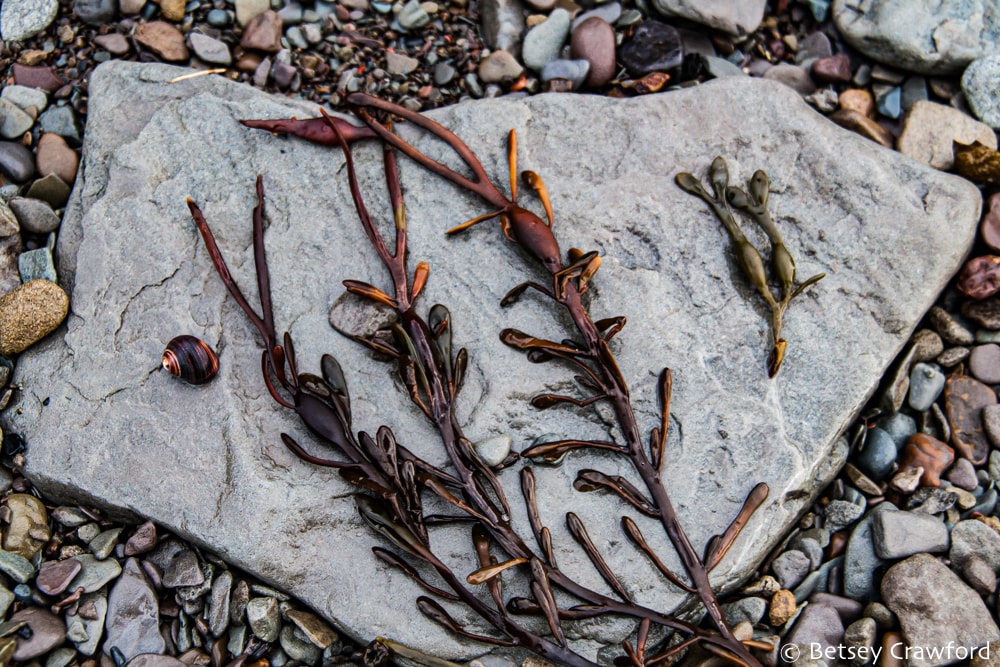

I, too, was spellbound by all of this, and by this quote: “Evolution is thrifty. No need to invent genetic information for every different life form or species. We all go back to the earliest bacterial life forms. The life force born in them is born in us anew.” Oh, to be conscious of the life force within when thinking of the world’s current problems! Thanks, Betsey, for this awesome reflection on evolution!
Thanks so much, Terri. Yes, if only we operated this way!
Hard to imagine a more enticing opening line than one beginning, “I fell down a 300 million year old rabbit hole…” I was hooked!
Also, “Evolution is thrifty.” We should be, too – or evolution will be so, for us.
Wonderful post!
Thank you! It was a delightful rabbit hole.